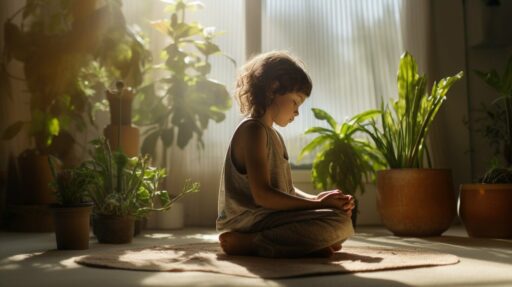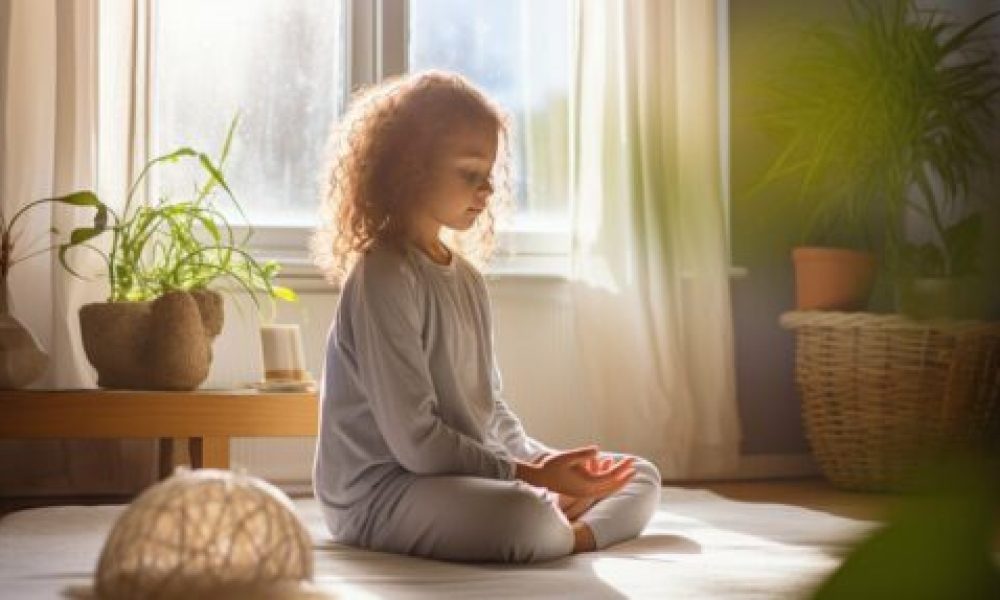Kids Morning Meditation: A Calm Start for Focused, Happy Days
Kids morning meditation helps children wake up centered, improves attention, and sets a peaceful tone that carries into better sleep at night. In just five minutes, your child can reset their body, mind, and mood—no special tools required.

Key Takeaways: kids morning meditation
- Kids morning meditation primes attention and self-regulation before school.
- Short, consistent practice lowers stress and eases transitions throughout the day.
- Pair mindfulness with steady sleep routines for the strongest benefits.
- Calm spaces and breathable bedding make it easier for kids to settle.
At a Glance
Quick summary: Start with 2–5 minutes, keep it playful, and anchor practice to a habit like breakfast. Combine kids morning meditation with good sleep hygiene to boost focus, mood, and bedtime ease.
The Science Snapshot: Why Sleep + Mindfulness Works for Kids
Answer first: Solid sleep helps thinking and mood; morning mindfulness supports those same systems during the day.
Healthy sleep in childhood is tied to sharper attention, stronger memory, and steadier emotions. Short mindfulness routines lower stress reactivity and teach kids to notice feelings before they spill over. That calm baseline often carries into smoother evenings and easier bedtimes. For background, see Sleep Foundation on children and sleep and practical sleep strategies for kids.
Morning Practice, Nighttime Payoff
Answer first: Calm mornings reduce the day’s stress load, which makes winding down at night easier.
Think of stress like a bucket: the less you pour in early, the less spills out later. A brief kids morning meditation lowers baseline arousal, so there’s less “carryover” into the evening. Pair it with a predictable evening rhythm like our nighttime routine and gentle bedtime rituals for a full 24-hour calm cycle.
Kids Morning Meditation: A 5-Minute, Playful Routine
Answer first: Use this simple script; keep it friendly and flexible so kids enjoy it and want to repeat it daily.
- Settle (30–45 sec): Sit tall or lie on a cozy rug. Hands on belly. “Feel the warm air in, soft air out.”
- Balloon Breaths (60 sec): “Breathe in and puff your belly like a balloon; breathe out and let it shrink.” Count 1–4 in, 1–4 out.
- Wake-Up Stretch (45 sec): Reach to the sky, wiggle fingers, roll shoulders. “Stretch like a yawning cat.”
- Body Scan (60 sec): “Can you feel your toes? Knees? Tummy? Heart? Jaw?” Invite them to soften each spot.
- Focus Game (30 sec): Pick a sound (a chime or birds). “Listen until it fades.” Or count ten breaths together.
- Kind Intention (30 sec): “Today I will be curious and kind.” Let kids choose their word.

If your child likes audio, adapt a short exercise from Sleep Foundation’s relaxation exercises for a morning reset. These simple cues also prepare kids to try the bedtime-friendly 4-7-8 breathing technique when winding down.
Make It Stick
Answer first: Consistency beats duration—anchor meditation to a routine you already do.
- Pair with breakfast or teeth brushing so it never gets skipped.
- Use a stuffed animal as a “breathing buddy” that rises and falls on the belly.
- Celebrate effort, not perfection—two calm breaths count.
Build a Supportive Sleep–Wake Environment
Answer first: A calm bedroom and steady rhythm translate morning mindfulness into better nights.
Reduce clutter, dim harsh light, and use warm, gentle bulbs for a cozy vibe. Soft textiles cue comfort, and choosing organic bedding or naturally breathable materials helps kids stay comfy. Families who prefer sustainable bedding and eco-conscious sheets often notice fewer night wakeups from overheating. For material guidance, see Parachute Home’s Fabric & Bedding Materials Guide.
Simple Room Tweaks That Help
Answer first: Small design choices make it easier for kids to wind down and wake up well.
- Keep pathways clear and toys in bins to lower overstimulation.
- Choose restful colors and soft textures to cue relaxation.
- Reserve the bed for sleep and quiet reading when possible.
For layout mistakes that can disrupt sleep, Better Homes & Gardens outlines practical fixes in their guide to bedroom layout mistakes.
Kid-Friendly Meditation Prompts (You Can Read Aloud)
Answer first: Short, sensory cues keep practice playful; rotate them to stay fresh.
- Color Breath: “Breathe in a calm blue. Breathe out any grumps.”
- Feather Focus: Balance a feather on the hand while breathing slowly.
- Five-Finger Breathing: Trace each finger while inhaling up and exhaling down.
- Gratitude Spark: “Name one thing you’re excited to learn today.”
- Quiet Animal: “Rest like a cozy fox in its den.”
How This Fits with What We Know About Sleep & Learning
Answer first: Sleep strengthens memory and mood, while morning meditation helps kids use those skills during the day.
Sleep supports memory consolidation, attention, and mood—foundations for school success. When morning mindfulness reduces stress and improves focus, children are more ready to learn and practice those cognitive skills. For a clear overview, see Sleep Foundation on memory and sleep.

Buyer’s Corner: Cozy, Sustainable Bedding for Calm Mornings
Answer first: Comfort matters; breathable, thoughtfully made textiles help kids feel safe and settled.
Look for certifications (OEKO-TEX®, GOTS) and natural fibers that breathe. If your household prefers organic bedding or sustainable bedding, consider cotton percale, sateen, or linen. Parachute’s material guides break down pros and cons so you can choose eco-conscious sheets that feel great and last. Start with their organic bedding guide.
FAQ
- How long should kids morning meditation be?
- Two to five minutes is plenty to start. Keep it fun and end while your child still enjoys it.
- What age can we begin?
- Preschoolers can try short breathing games. Older kids can add body scans and set a daily intention.
- When will we notice benefits?
- Many families see calmer transitions within one to two weeks of daily practice, especially with steady bedtime routines.
- Will this help bedtime too?
- Often yes—lower stress makes winding down easier. Pair mornings with quiet evening rituals and a cozy, low-clutter space.
- Where can I learn more about sleep and kids?
- See Sleep Foundation’s resources on children and sleep and sleep strategies.
Final Thoughts
With a few playful breaths and a kind intention, kids morning meditation can color the whole day with calm—and bedtime too. For more routines and sleep-smart ideas, explore Cozy Bed Quarters’ bedtime rituals and related guides below.























